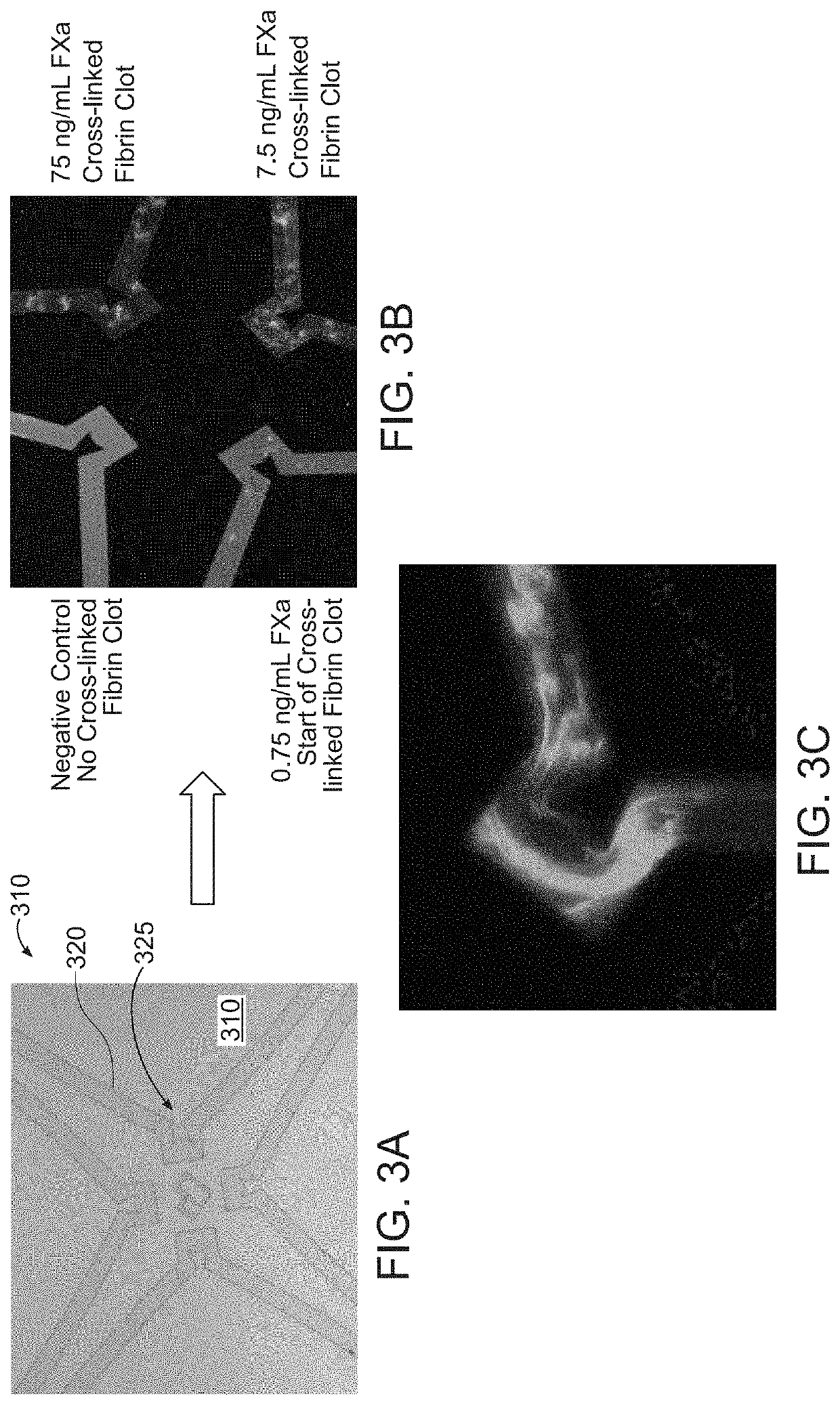Methods and devices for detection of coagulation impairment
a technology of impairment and coagulation, applied in the field of methods and devices for detecting impairment, can solve the problems of abnormal or impaired clot degradation, abnormal or impaired clot formation, and type of coagulation management is not possible using traditional factor deficiency and inhibitor
- Summary
- Abstract
- Description
- Claims
- Application Information
AI Technical Summary
Benefits of technology
Problems solved by technology
Method used
Image
Examples
example 1
[0176]FIGS. 1A-1D are schematic illustrations of microfluidic device layouts according to example embodiments of the invention.
[0177]FIG. 1A is a top view of a circular layout (it can also be any symmetrical polygon with a center point) of microfluidic device 10 having one or more continuous microfluidic channels (e.g., microchannels) 20 formed in a substrate 15, each channel connected to one inlet (input port) 30 and one outlet (output port) 35. A portion of the channel, e.g., the center of the channel, can have a unique shape, e.g., a clot forming / localizing area 25, in order to result in flow separation or disruption, or stasis of sample flow to promote clot formation. There may be two or more of these microfluidic channels in this single device, dependent on the specific assay being used. This design can allow for multiple samples, such as three or more samples, e.g., up to 10 samples, or more than 10 samples, to be evaluated simultaneously. Typically, each sample (or each aliqu...
example 2
[0185]A general protocol for performing the assay according to an embodiment of the invention is as follows:[0186]a) Add together sample, agonist, + / − calcium, + / − clot detection agent[0187]i. Calcium to a final concentration between 0.005-0.05 M (This concentration is particularly suitable for use with 3.2% buffered sodium citrate. If another anticoagulant is used, the concentration of calcium may not be 0.02 M.)[0188]ii. Clot detection agents can include fluorescent labeled fibrinogen, magnets, beads (may be fluorescent or colored)[0189]b) Load into microfluidic device[0190]i. See, e.g., FIGS. 1A-1D, 2A and 2B for examples of input loading configuration and order[0191]c) Temperature control[0192]i. Room temperature[0193]ii. May increase up to 37° C. (body temperature) (Body temperature is typically 37° C. but the temperature of the assay run can be changed according to the patient's actual temperature. For example, if a patient has a fever, the temperature of the assay run can be ...
example 3
[0196]FIGS. 3A-3C illustrates clot detection using plasma and fluorescent-labeled fibrinogen with a microfluidic device 310 having four channels 320 with clot forming / localizing areas 225 according to an example embodiment. The microfluidic device is similar to the device show in FIGS. 2A and 2B except that all clot forming areas 325 have the same shape. Each clot forming / localizing area 325 includes a protrusion to disrupt sample flow. In this example, as shown in FIG. 3A, the protrusion generally is triangular in shape. Two sides of the protrusion are straight and one side is concave. Each clot forming area 325 causes the flow to change direction four times, including two 90 degree changes in direction.
[0197]In an example, the process of clot detection can include the following procedural steps:[0198]a) A plasma sample is pre-mixed to include: 6 μL plasma+0.6 μL agonist (10% volume to sample)+0.6 μL Calcium (stock 200 mM, 10% volume to sample)+0.6 μL Fibrinogen (this can vary in c...
PUM
| Property | Measurement | Unit |
|---|---|---|
| volume | aaaaa | aaaaa |
| volume | aaaaa | aaaaa |
| concentration | aaaaa | aaaaa |
Abstract
Description
Claims
Application Information
 Login to View More
Login to View More - R&D
- Intellectual Property
- Life Sciences
- Materials
- Tech Scout
- Unparalleled Data Quality
- Higher Quality Content
- 60% Fewer Hallucinations
Browse by: Latest US Patents, China's latest patents, Technical Efficacy Thesaurus, Application Domain, Technology Topic, Popular Technical Reports.
© 2025 PatSnap. All rights reserved.Legal|Privacy policy|Modern Slavery Act Transparency Statement|Sitemap|About US| Contact US: help@patsnap.com



